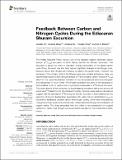Files in this item
Feedback between carbon and nitrogen cycles during the Ediacaran Shuram excursion
Item metadata
| dc.contributor.author | Xu, Dongtao | |
| dc.contributor.author | Wang, Xinqiang | |
| dc.contributor.author | Shi, Xiaoying | |
| dc.contributor.author | Peng, Yongbo | |
| dc.contributor.author | Stüeken, Eva E. | |
| dc.date.accessioned | 2021-06-21T09:30:01Z | |
| dc.date.available | 2021-06-21T09:30:01Z | |
| dc.date.issued | 2021-05-25 | |
| dc.identifier | 274557448 | |
| dc.identifier | 5033aef3-4a29-41b1-ad81-42fe022e8ab0 | |
| dc.identifier | 000658818500001 | |
| dc.identifier | 85107556017 | |
| dc.identifier.citation | Xu , D , Wang , X , Shi , X , Peng , Y & Stüeken , E E 2021 , ' Feedback between carbon and nitrogen cycles during the Ediacaran Shuram excursion ' , Frontiers in Earth Science , vol. 9 , 678149 . https://doi.org/10.3389/feart.2021.678149 | en |
| dc.identifier.issn | 2296-6463 | |
| dc.identifier.other | Jisc: 67255c29e233460897e4e087e749d6cf | |
| dc.identifier.other | publisher-id: 678149 | |
| dc.identifier.other | ORCID: /0000-0001-6861-2490/work/95418635 | |
| dc.identifier.uri | https://hdl.handle.net/10023/23398 | |
| dc.description | This research is supported by the National Natural Science Foundation of China (41872032, 41830215, 41930320) and the Chinese ‘111’ project (B20011). | en |
| dc.description.abstract | The middle Ediacaran Period records one of the deepest negative carbonate carbon isotope (δ13Ccarb) excursions in Earth history (termed the Shuram excursion). This excursion is argued by many to represent a large perturbation of the global carbon cycle. If true, this event may also have induced significant changes in the nitrogen cycle, because carbon and nitrogen are intimately coupled in the global ocean. However, the response of the nitrogen cycle to the Shuram excursion remains ambiguous. Here, we reported high resolution bulk nitrogen isotope (δ15N) and organic carbon isotope (δ13Corg) data from the upper Doushantuo Formation in two well-preserved sections (Jiulongwan and Xiangerwan) in South China. The Shuram-equivalent excursion is well developed in both localities, and our results show a synchronous decrease in δ15N across the event. This observation is further supported by bootstrapping simulations taking into account all published δ15N data from the Doushantuo Formation. Isotopic mass balance calculations suggest that the decrease in δ15N during the Shuram excursion is best explained by the reduction of isotopic fractionation associated with water column denitrification (εwd) in response to feedbacks between carbon and nitrogen cycling, which were modulated by changes in primary productivity and recycled nutrient elements through remineralization of organic matter. The study presented here thus offers a new perspective for coupled variations in carbon and nitrogen cycles and sheds new light on this critical time in Earth history. | |
| dc.format.extent | 15 | |
| dc.format.extent | 3941183 | |
| dc.language.iso | eng | |
| dc.relation.ispartof | Frontiers in Earth Science | en |
| dc.subject | Ediacaran | en |
| dc.subject | South China | en |
| dc.subject | Doushantuo Formation | en |
| dc.subject | Shuram excursion | en |
| dc.subject | Nitrogen isotopes | en |
| dc.subject | GE Environmental Sciences | en |
| dc.subject | DAS | en |
| dc.subject.lcc | GE | en |
| dc.title | Feedback between carbon and nitrogen cycles during the Ediacaran Shuram excursion | en |
| dc.type | Journal article | en |
| dc.contributor.institution | University of St Andrews. School of Earth & Environmental Sciences | en |
| dc.contributor.institution | University of St Andrews. St Andrews Centre for Exoplanet Science | en |
| dc.identifier.doi | https://doi.org/10.3389/feart.2021.678149 | |
| dc.description.status | Peer reviewed | en |
This item appears in the following Collection(s)
Items in the St Andrews Research Repository are protected by copyright, with all rights reserved, unless otherwise indicated.

